tow FORD MUSTANG 2007 5.G Shelby GT500 Supplement Manual
[x] Cancel search | Manufacturer: FORD, Model Year: 2007, Model line: MUSTANG, Model: FORD MUSTANG 2007 5.GPages: 40, PDF Size: 0.32 MB
Page 1 of 40
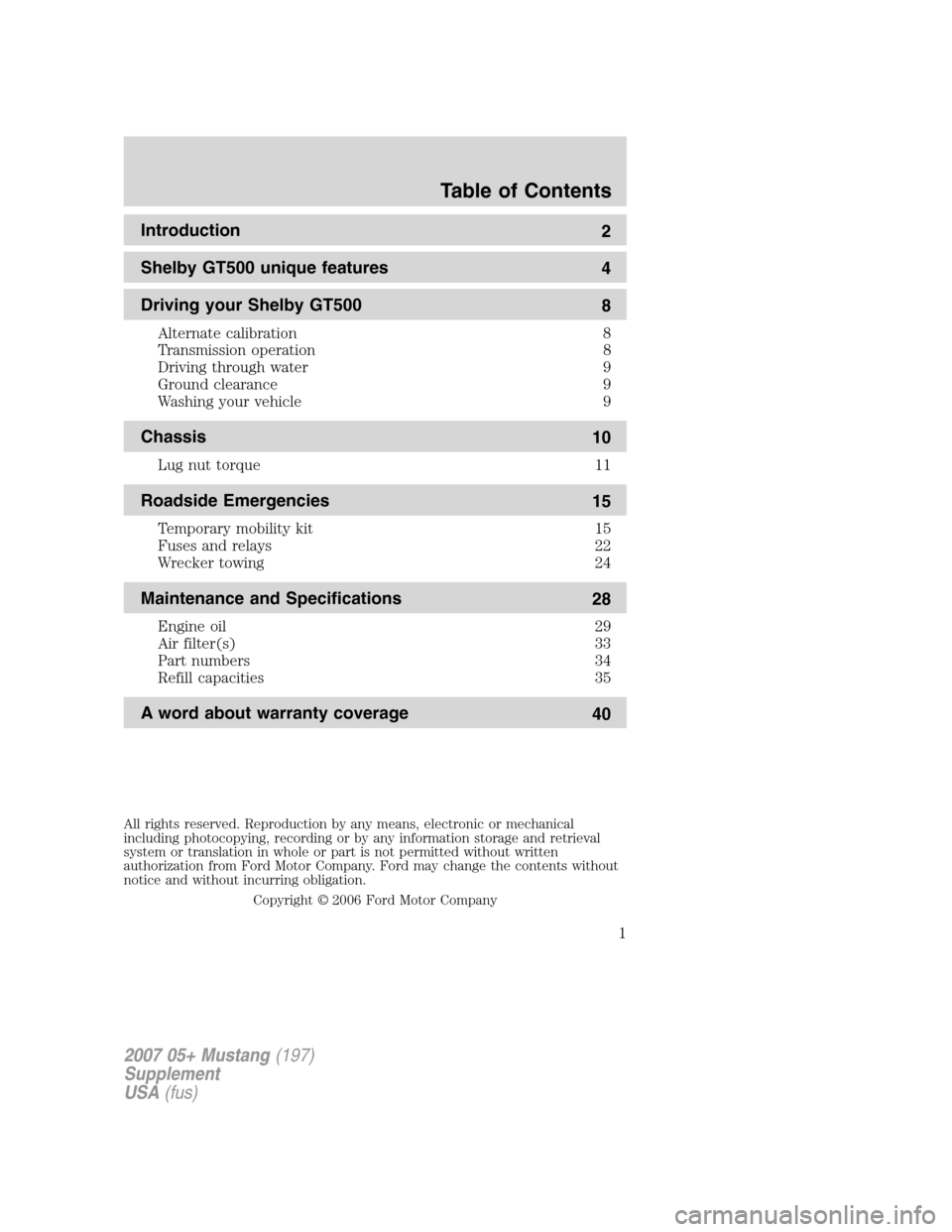
Introduction
2
Shelby GT500 unique features
4
Driving your Shelby GT500
8
Alternate calibration 8
Transmission operation 8
Driving through water 9
Ground clearance 9
Washing your vehicle 9
Chassis
10
Lug nut torque 11
Roadside Emergencies
15
Temporary mobility kit 15
Fuses and relays 22
Wrecker towing 24
Maintenance and Specifications
28
Engine oil 29
Air filter(s) 33
Part numbers 34
Refill capacities 35
A word about warranty coverage
40
All rights reserved. Reproduction by any means, electronic or mechanical
including photocopying, recording or by any information storage and retrieval
system or translation in whole or part is not permitted without written
authorization from Ford Motor Company. Ford may change the contents without
notice and without incurring obligation.
Copyright © 2006 Ford Motor Company
Table of Contents
1
2007 05+ Mustang(197)
Supplement
USA(fus)
Page 16 of 40
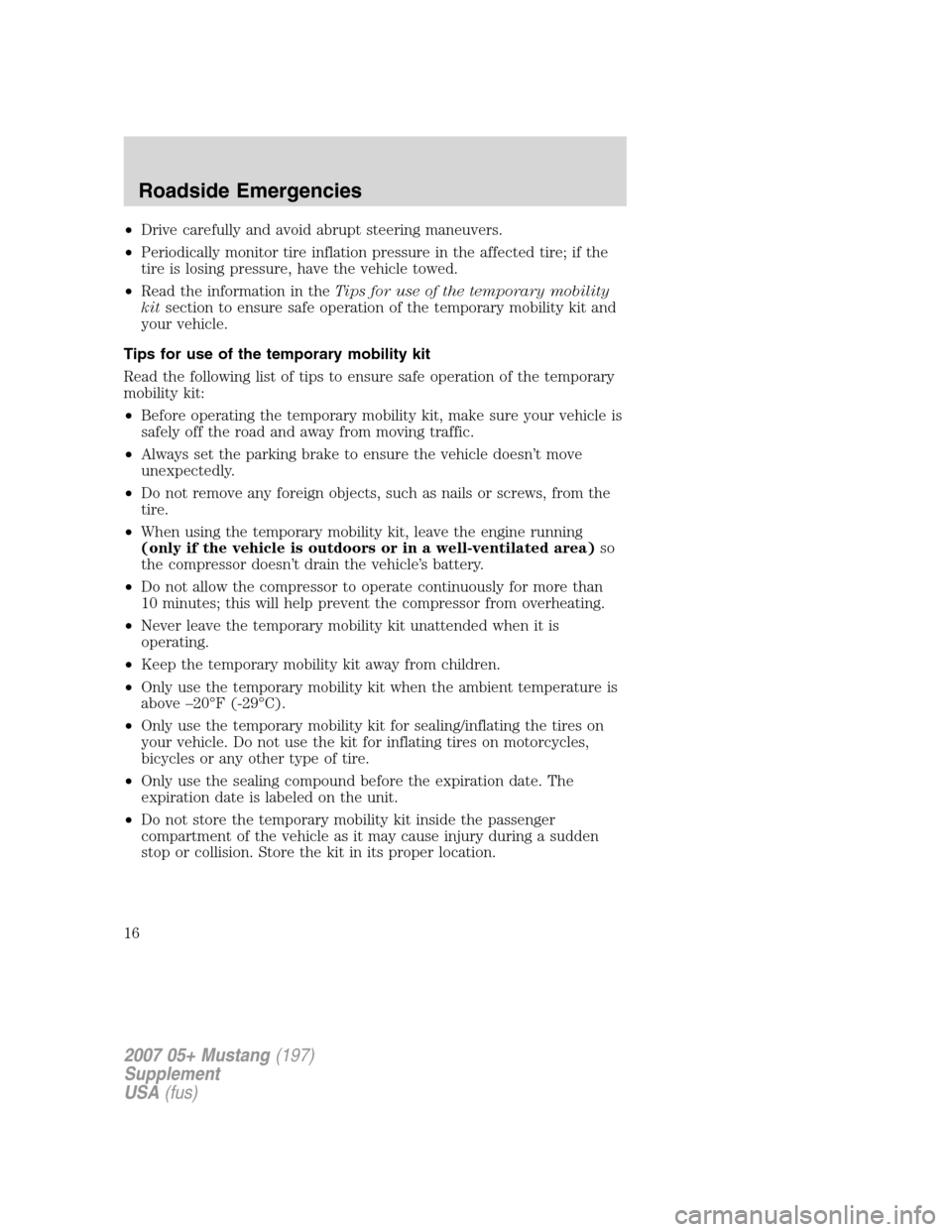
•Drive carefully and avoid abrupt steering maneuvers.
•Periodically monitor tire inflation pressure in the affected tire; if the
tire is losing pressure, have the vehicle towed.
•Read the information in theTips for use of the temporary mobility
kitsection to ensure safe operation of the temporary mobility kit and
your vehicle.
Tips for use of the temporary mobility kit
Read the following list of tips to ensure safe operation of the temporary
mobility kit:
•Before operating the temporary mobility kit, make sure your vehicle is
safely off the road and away from moving traffic.
•Always set the parking brake to ensure the vehicle doesn’t move
unexpectedly.
•Do not remove any foreign objects, such as nails or screws, from the
tire.
•When using the temporary mobility kit, leave the engine running
(only if the vehicle is outdoors or in a well-ventilated area)so
the compressor doesn’t drain the vehicle’s battery.
•Do not allow the compressor to operate continuously for more than
10 minutes; this will help prevent the compressor from overheating.
•Never leave the temporary mobility kit unattended when it is
operating.
•Keep the temporary mobility kit away from children.
•Only use the temporary mobility kit when the ambient temperature is
above –20°F (-29°C).
•Only use the temporary mobility kit for sealing/inflating the tires on
your vehicle. Do not use the kit for inflating tires on motorcycles,
bicycles or any other type of tire.
•Only use the sealing compound before the expiration date. The
expiration date is labeled on the unit.
•Do not store the temporary mobility kit inside the passenger
compartment of the vehicle as it may cause injury during a sudden
stop or collision. Store the kit in its proper location.
2007 05+ Mustang(197)
Supplement
USA(fus)
Roadside Emergencies
16
Page 19 of 40
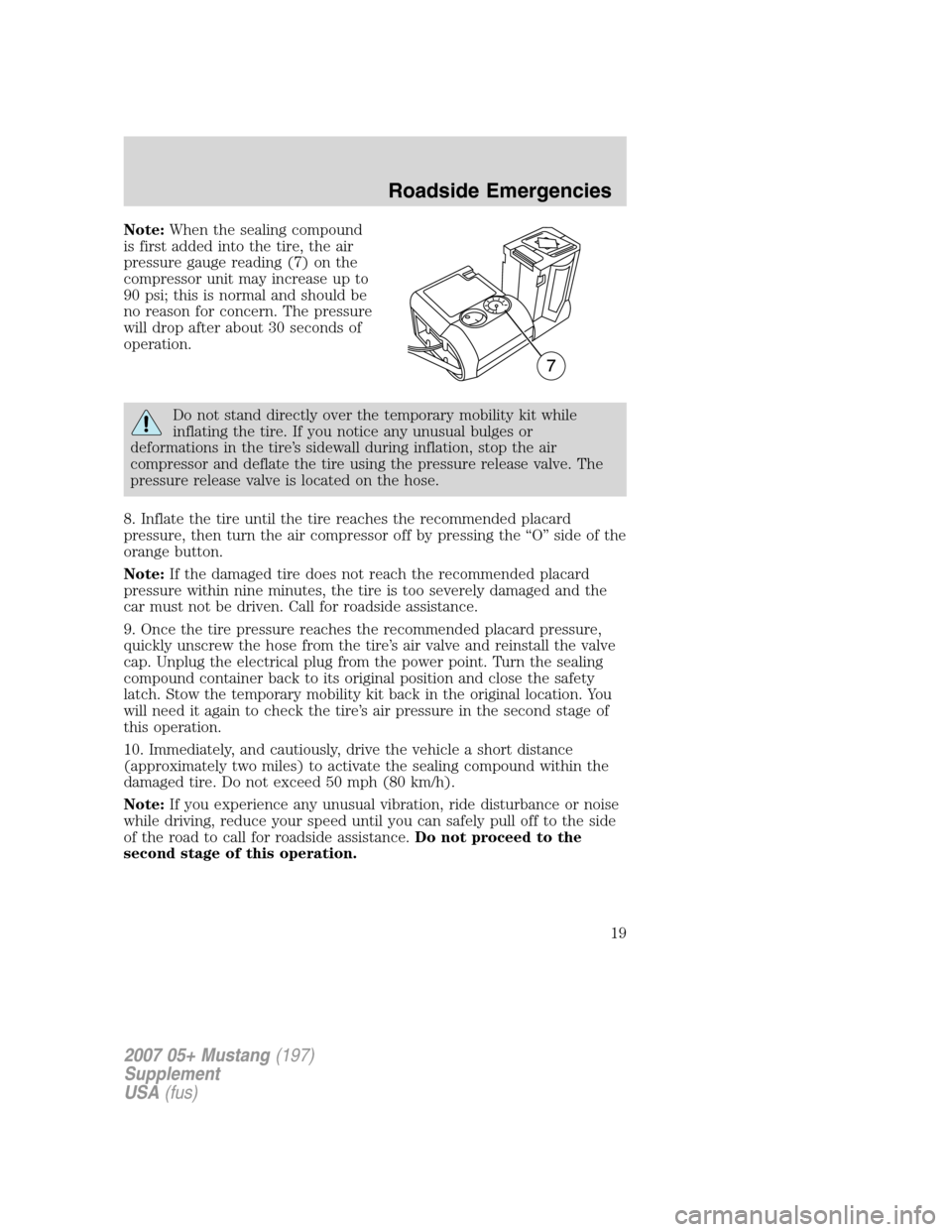
Note:When the sealing compound
is first added into the tire, the air
pressure gauge reading (7) on the
compressor unit may increase up to
90 psi; this is normal and should be
no reason for concern. The pressure
will drop after about 30 seconds of
operation.
Do not stand directly over the temporary mobility kit while
inflating the tire. If you notice any unusual bulges or
deformations in the tire’s sidewall during inflation, stop the air
compressor and deflate the tire using the pressure release valve. The
pressure release valve is located on the hose.
8. Inflate the tire until the tire reaches the recommended placard
pressure, then turn the air compressor off by pressing the “O” side of the
orange button.
Note:If the damaged tire does not reach the recommended placard
pressure within nine minutes, the tire is too severely damaged and the
car must not be driven. Call for roadside assistance.
9. Once the tire pressure reaches the recommended placard pressure,
quickly unscrew the hose from the tire’s air valve and reinstall the valve
cap. Unplug the electrical plug from the power point. Turn the sealing
compound container back to its original position and close the safety
latch. Stow the temporary mobility kit back in the original location. You
will need it again to check the tire’s air pressure in the second stage of
this operation.
10. Immediately, and cautiously, drive the vehicle a short distance
(approximately two miles) to activate the sealing compound within the
damaged tire. Do not exceed 50 mph (80 km/h).
Note:If you experience any unusual vibration, ride disturbance or noise
while driving, reduce your speed until you can safely pull off to the side
of the road to call for roadside assistance.Do not proceed to the
second stage of this operation.
2007 05+ Mustang(197)
Supplement
USA(fus)
Roadside Emergencies
19
Page 21 of 40
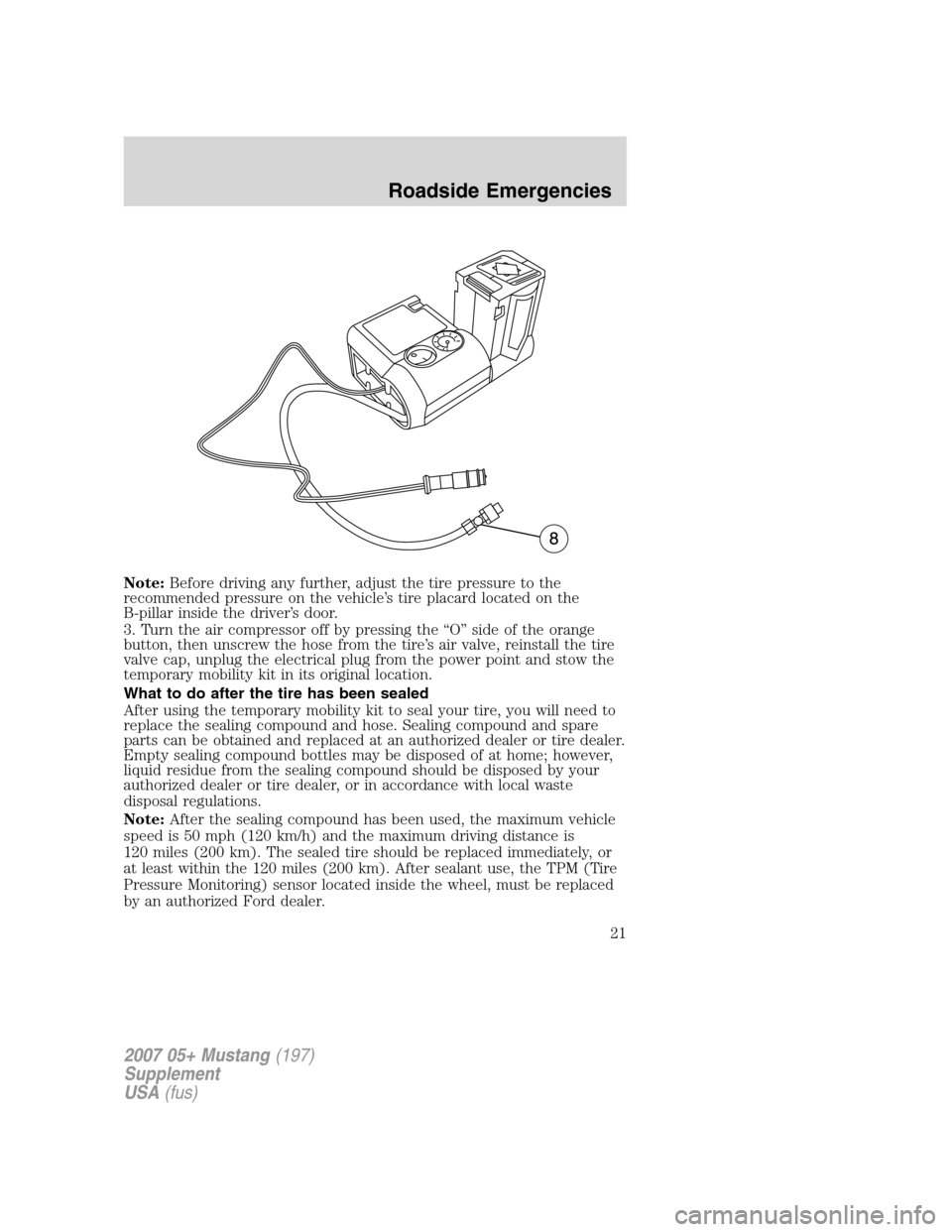
Note:Before driving any further, adjust the tire pressure to the
recommended pressure on the vehicle’s tire placard located on the
B-pillar inside the driver’s door.
3. Turn the air compressor off by pressing the “O” side of the orange
button, then unscrew the hose from the tire’s air valve, reinstall the tire
valve cap, unplug the electrical plug from the power point and stow the
temporary mobility kit in its original location.
What to do after the tire has been sealed
After using the temporary mobility kit to seal your tire, you will need to
replace the sealing compound and hose. Sealing compound and spare
parts can be obtained and replaced at an authorized dealer or tire dealer.
Empty sealing compound bottles may be disposed of at home; however,
liquid residue from the sealing compound should be disposed by your
authorized dealer or tire dealer, or in accordance with local waste
disposal regulations.
Note:After the sealing compound has been used, the maximum vehicle
speed is 50 mph (120 km/h) and the maximum driving distance is
120 miles (200 km). The sealed tire should be replaced immediately, or
at least within the 120 miles (200 km). After sealant use, the TPM (Tire
Pressure Monitoring) sensor located inside the wheel, must be replaced
by an authorized Ford dealer.
2007 05+ Mustang(197)
Supplement
USA(fus)
Roadside Emergencies
21
Page 24 of 40
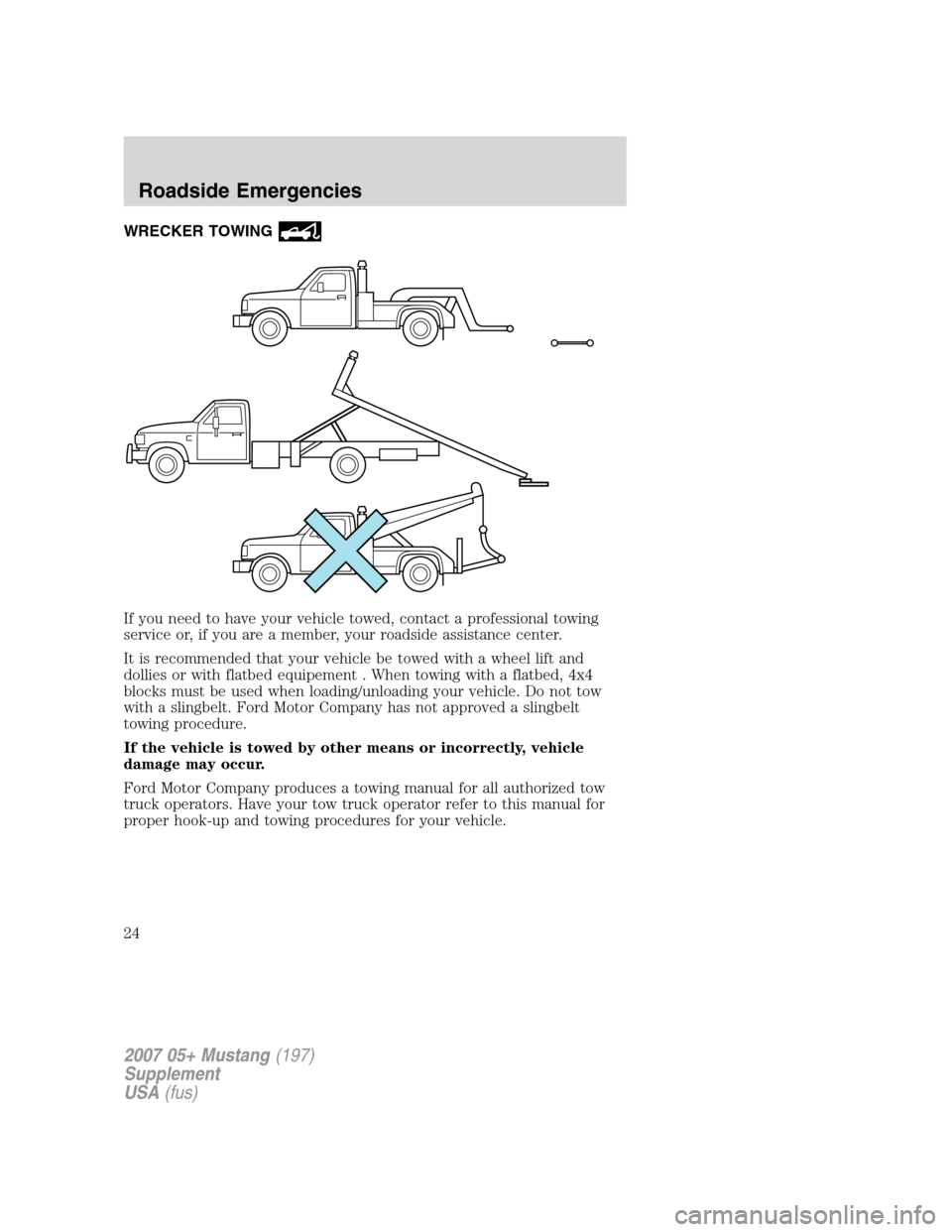
WRECKER TOWING
If you need to have your vehicle towed, contact a professional towing
service or, if you are a member, your roadside assistance center.
It is recommended that your vehicle be towed with a wheel lift and
dollies or with flatbed equipement . When towing with a flatbed, 4x4
blocks must be used when loading/unloading your vehicle. Do not tow
with a slingbelt. Ford Motor Company has not approved a slingbelt
towing procedure.
If the vehicle is towed by other means or incorrectly, vehicle
damage may occur.
Ford Motor Company produces a towing manual for all authorized tow
truck operators. Have your tow truck operator refer to this manual for
proper hook-up and towing procedures for your vehicle.
2007 05+ Mustang(197)
Supplement
USA(fus)
Roadside Emergencies
24
Page 25 of 40
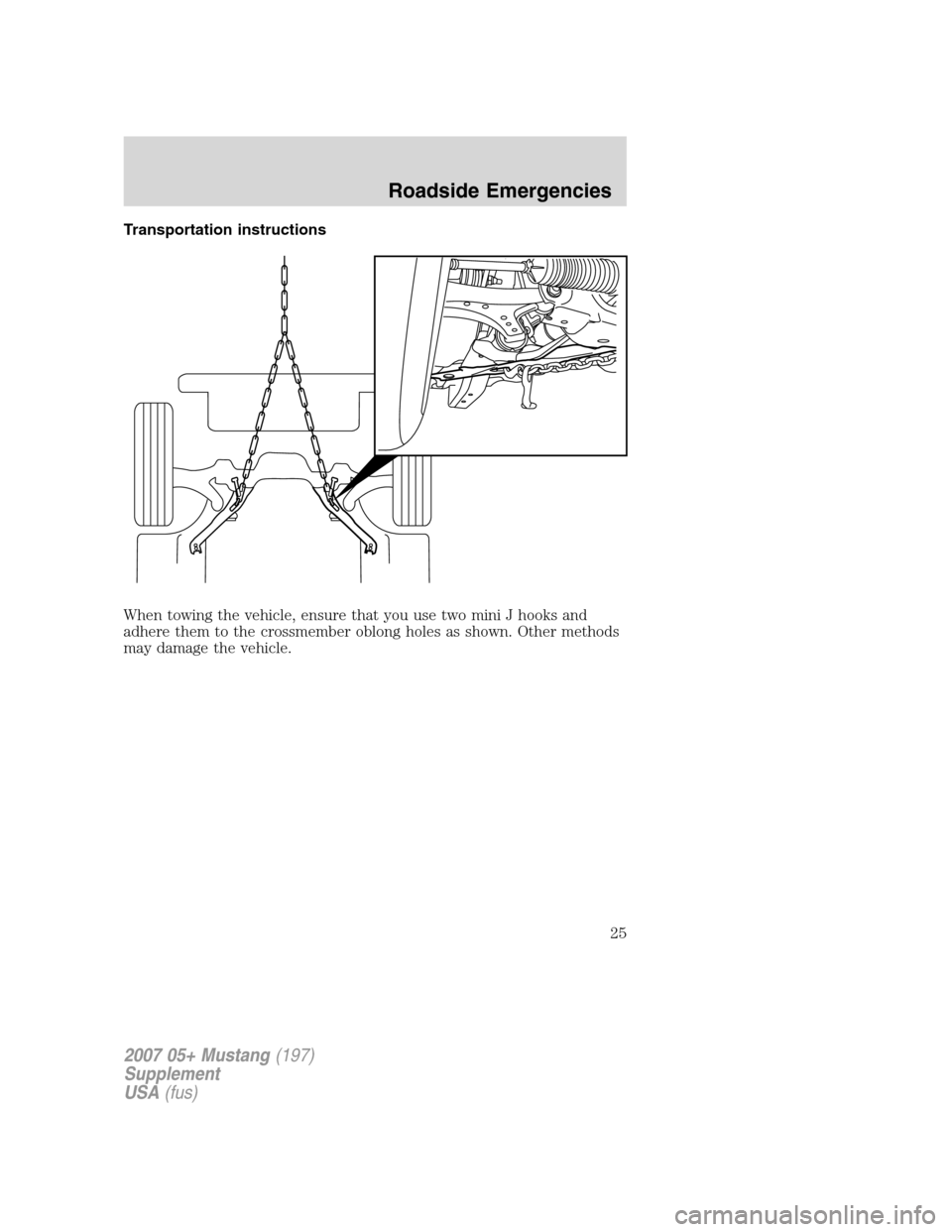
Transportation instructions
When towing the vehicle, ensure that you use two mini J hooks and
adhere them to the crossmember oblong holes as shown. Other methods
may damage the vehicle.
2007 05+ Mustang(197)
Supplement
USA(fus)
Roadside Emergencies
25
Page 26 of 40
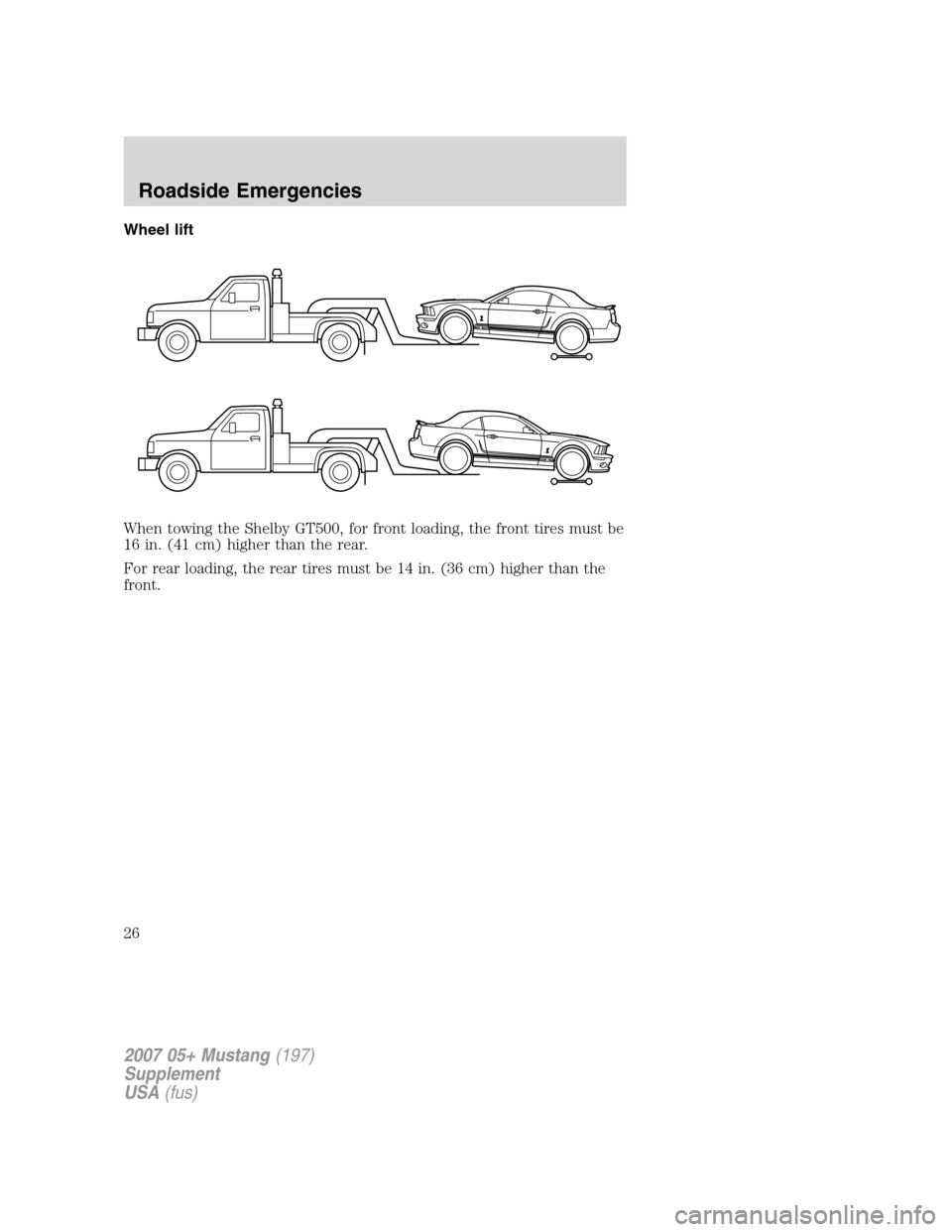
Wheel lift
When towing the Shelby GT500, for front loading, the front tires must be
16 in. (41 cm) higher than the rear.
For rear loading, the rear tires must be 14 in. (36 cm) higher than the
front.
2007 05+ Mustang(197)
Supplement
USA(fus)
Roadside Emergencies
26